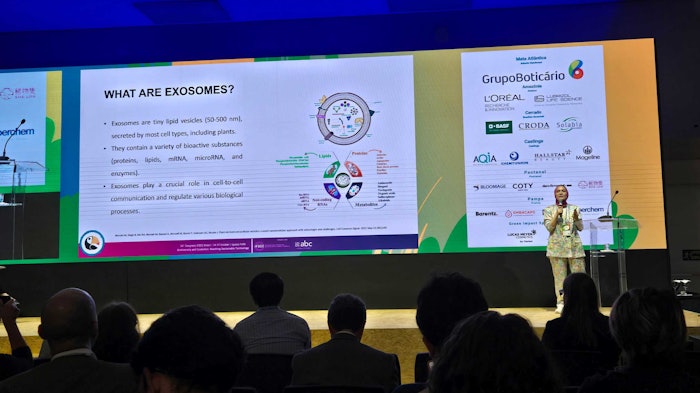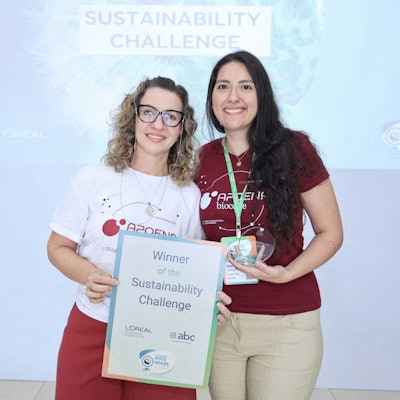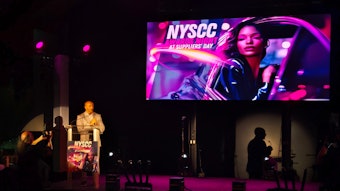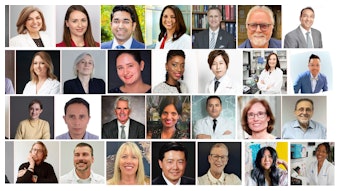
 Attendees engage in fragrance and product samples by Natura, including entering a VR sensory booth for an interactive experience.
Attendees engage in fragrance and product samples by Natura, including entering a VR sensory booth for an interactive experience.
During Day 2 of the IFSCC Congress, held Oct. 14-17, 2024, in Iguazu Falls, Brazil, the bold and bright exhibit hall and interwoven poster sessions bustled with activity against the steady rhythm of technical sessions.
Ingredient suppliers, testing, regulatory, digital platform and other service providers, as well as finished cosmetic manufacturers, densely packed the exhibit hall with their latest and greatest beauty innovations. And, with more than 600 (intermittently scheduled) poster presentations drawing intrigue, attendees worked their way through the crowd with a little samba swaying.
Just a few steps from the main exhibit hall, the Sustainability Room served as the forum for the Associaçao Brasileira de Cosmetologia's (ABC's) and L'Oréal Research and Innovation's Sustainability Challenge on day one, where six start-ups participated in a "pitch session" in hopes of winning passage to next year's IFSCC Congress. In addition, the Live Lab space afforded supplier companies the chance demonstrate their ingredients in formulating action.
Meanwhile, the day's talks opened with an exploration of cognitive science to promote sustainability, rolling into concepts including green plant metabolism, skin barrier integrity and inflammation, collagen and longevity, skin brightening and acne, sun protection and a seaweed photoprotection test, AI hydration prediction and more. Following is a brief re-cap.
 From L: Rachel Grabenhofer, C&T, gets a hands-on lesson during the poster session from Shiseido's Tomonobu Ezure, Ph.D., about a new approach to reverse skin sagging: by targeting a newly identified "Skin Morphology-Maintaining Gigantic 'Dermal-Skeleton' Structure."
From L: Rachel Grabenhofer, C&T, gets a hands-on lesson during the poster session from Shiseido's Tomonobu Ezure, Ph.D., about a new approach to reverse skin sagging: by targeting a newly identified "Skin Morphology-Maintaining Gigantic 'Dermal-Skeleton' Structure."
Interactive Exhibition and Poster Sessions
From VR, sensory-enhanced experiences and hands-on ingredient and product interactions, to in-person poster presentations, the exhibit hall buzzed with energy. Provocative posters explored bubbles in place of surfactants for cleansing; answers to intimate malodor and hygiene; hot springs to improve skin health; "mirror skin” generated from one’s own urine; and more.
Live Lab and ABC's/L'Oreal's Sustainability Challenge
The Live Lab gave ingredient suppliers the opportunity to show attendees their ingredients in action; such as a demo by Aquia showing how to formulate a sulfate-free gel soap with Soft Care MLMG (INCI: Maltitol Laurate (and) Maltooligosyl Glucoside (and) Water (Aqua).
 Live Lab demo of a sulfate-free gel soap by Aquia
Live Lab demo of a sulfate-free gel soap by Aquia
In addition, as noted, the Associaçao Brasileira de Cosmetologia (ABC), supported by L'Oréal Research and Innovation, held a Sustainability Challenge on Day 1, with pitches from six companies. These included:
- CE LAB - Using the Systems Dynamics method, the company developed a tool to assess the decarbonization potential of the cosmetic sector's scope 3 (emissions from packaging production and disposal to fight climate change) through the implementation of Circular Economy strategies.
- TOCAAR - The company specializes in transforming sisal plant leaf fiber waste to an extract and finally, a high-performance nano-serum with antioxidant, anti-hyperpigmentation and moisturizing properties.
- NUN - Through the company's combination of upcycling agro-industrial by-products and clean nano technologies, the company creates sustainable raw materials for cosmetics. Key to this is its natural nanocarrier platform, which reportedly harnesses the benefits of nanotech without compromising the natural index of cosmetic formulas.
 APOENA won the 2024 Sustainability Challenge
APOENA won the 2024 Sustainability Challenge - BIOAROMA, which developed lipase-biotransformed licuri oil as a natural cosmetic ingredient to improve odor and antimicrobial action.
- OBYKAA - a company focused on surfactants in the Tiete River in Sao Paulo/Brazil due to the rubber latex industry.
- And the winner: APOENA - a company focused on bioprospecting by minimally invasively collecting samples of microorganisms from various ecosystems to create a catalogue (especially before species become extinct) for potential future cosmetic and other use. Per the company, this eliminates the need for future interventions in the environment.
Sustainable Beauty: Cognitive Science, Green Chemistry, AI-driven Upcycled Exosomes
In tandem, the conference opened with David Morizet, Ph.D., of L'Oreal, who gave the keynote; "From formula to packaging, the power of cognitive science to promote sustainable beauty experience." Julie Zimmerman, Ph.D., presented on the beauty of green chemistry, and another keynote from Sylesh Venkataraman, Ph.D., of Lubrizol, highlighted how to orchestrate the "green symphony of plant metabolism."
Tugba Sagir, of Pim Grup Consultancy, described the development of exosomal raw material from upcycled purslane (Portulaca oleracea) waste, obtained by green chemistry and using AI modeling. "Exosomes are one of the latest cosmetic innovations," she said, highlighting several examples of plant exosomes and their useful properties.
The work presented showed that purslane plant-derived exosomes have "statistically significant proliferative effects on human mesenchymal stem cells (hMSCs)." Considering their tissue regeneration capabilities, per Sagir, repopulating stem cells using these plant-derived exosomes can provide real benefits, especially for longevity and anti-aging processes.
Skin Biology: Barrier Integrity, Absorption, Inflammation Test Model, Botanical Holobiont for Atopic Skin, AI Hydration Prediction
In terms of skin care and biology, Samara Eberlin, of Kosmoscience, presented the clinical assessment of a skin care formulation in modulating biological mechanisms involved in skin barrier integrity. Fan Liu, of CosMax, highlighted how a droplet surface makes skin absorption different with a study of skin penetration in biosurfactant glycolipids-incorporated liposomes.
Zijian Liu, from Shenzhen Winkey, outlined the protective effect of a small oligopeptide on UVB-induced skin barrier dysfunction, while Bibiana Franzen Matte, from Nucleo Vitro, explored a biomimetic skin equivalent model with inflammation induction properties.
Another keynote from Caroline Malhaire Delefosse, of Solabia, demonstrated a novel bio-inspired glycolipid from a plant holobiont to target atopic-prone skin disorders. Lastly, Higor Yudi Duenha Sigaki, from Grupo Boticário, showed how artificial intelligence can be used as a tool to predict cosmetics hydration properties.
Skin Aging: Photo-aging Prediction, Pro-collagen Solution, Hyperpigmentation Control, Longevity in Women 80+, TXA and Skin Brightening
Focused on skin aging, Mariane Massufero Vergilio, of UNICAMP - Campinas State University, presented the talk, "Advancing Facial Aging Assessment: Machine Learning in High-Resolution Imaging for Photoaging Prediction." Gina Puig, from Natura Bissé, described a pro-collagen solution using a firming ingredient combination that enhances results while maximizing skin tolerance.
Frederic Flament, of L´Oreal, highlighted a novel combination of hyperpigmentation control agents to personalize treatments for all skin tones and related disorders, while Pedro Paulo Soldati, of Natura, took a closer look at women over 80 with a longevity assessment from the perspective of the skin biophysics, metagenomics and lipidomics, before and after cosmetic intervention with Brazilian biodiversity ingredients.
 Kamilia Kemel, from Chanel, described the in vivo assessment of dermal fibers by LC-OCT, showing variations with age and ethnicity, and for the first time, their organization after the application of skin care cosmetic products.
Kamilia Kemel, from Chanel, described the in vivo assessment of dermal fibers by LC-OCT, showing variations with age and ethnicity, and for the first time, their organization after the application of skin care cosmetic products.
Kamilia Kemel, from Chanel, described the in vivo assessment of dermal fibers by LC-OCT, showing variations with age and ethnicity, and for the first time, their organization after the application of skin care cosmetic products. Jing Wang, of Proya Cosmetics, gave mechanistic insights into the whitening effect of a combination of W335 and tranexamic acid (namely the involvement of the ubiquitin-proteasome system and autophagy in melanogenesis. Ima Multazimah, CosMax, presented on the efficacy of Indonesia green tea (Camellia sinensis) leaf extract as a natural brightening and anti-acne agent for human skin.
In the color sector, Cristhianne Miranda Coutinho, from Grupo Boticário, presented the development of a liquid foundation emulsion (water/silicone) and the combination of active ingredients with treatment benefits for overnight use.
Advances in Sun: Seaweed Photoprotection, Nanosilica Protection, UV Filter-free and Surfactant-free Sun Protection
Marc Pissavini, Ph.D., from Coty, gave a comprehensive overview on two decades of advancements in SPF determination, while Keila Almeida Santana, from the University of State of Bahia, explored the photoprotective potential of seaweeds through alternative methods to animal testing. Mauricio da Silva Baptista, from the University of São Paulo, spoke on core/shell melanin/nanosilica as a novel material for improved sun protection.
Marcella Gabarra Almeida Leite, from TRI Princeton, presented a method to evaluate sun damage and future sunscreen products more efficiently, more safely and more eco-friendly. Claudio Ribeiro, from Lubrizol Life Science, outlined the automated in vitro analysis of UV protection performance of powder sunscreen products.
 Ikuya Ohshima, of Kosé, explored a novel powder-dispersing system for skin-friendly cosmetics; more specifically, a polymer gel network that boosts and maintains UV protection without UV absorbers or surfactants.
Ikuya Ohshima, of Kosé, explored a novel powder-dispersing system for skin-friendly cosmetics; more specifically, a polymer gel network that boosts and maintains UV protection without UV absorbers or surfactants.
Finally, Ikuya Ohshima, of Kosé, explored a novel powder-dispersing system for skin-friendly cosmetics; more specifically, a polymer gel network that boosts and maintains UV protection without UV absorbers or surfactants. The silicone/polyurethane hybrid film former (SIPU) created a flexible, non-rigid film without causing stress to skin. Ohshima explained it is more than a film former, it is a novel dispersant for use in a wide variety of applications including color.
Hair and Scalp: Curl Care, Diversity, Taurine for Seborrheic Dermatitis, Zeolite in Bleaching
In the hair and scalp sector, Deborah Netto de Barros, from L´Oreal, presented, "Embracing Diversity: Bridging the Gap for Curly and Very Curly Formulations with In Vitro and Machine Learning Performance Prediction." Érica Savassa Pinto Cacoci, from UNESP - São Paulo State University, highlighted the use of taurine to treat seborrheic dermatitis, which is currently in pilot clinical study phases I and II. And, Diana Dashi, from Università degli studi di Trieste, offered a natural zeolite as a sustainable substitute to traditional chelating agents in hair bleaching.
Sensory in Cosmetics: AI Innovation, TDS Approach, Cosmetics and Sensory Tools
Jeong Yu Lee, from AmorePacific, described an artificial tactile sensory system and high-precision AI simulation for cosmetic products while Dian Widya Ningtyas, from Universitas Brawijaya, similarly explored the dynamic sensory evaluation of skin creams during application using Temporal Dominance of Sensation (TDS).
Takaya Oishi, from Pola Chemicals, asked: "Does the cosmetic stimulation of brain regions involved in multiple senses amplify multisensory perception?" and offered that, beyond their traditional benefits, cosmetics act as potential sensory transformation tools. And Audrey Maniere, from Lucas Meyer, combined fMRI and EEG for a unique multi-level neurosensory approach of tactile stimulation offered by creams.
Odor Control: Glutathione Masking, Axillary Mechanisms
Finally, Murat Kadir, from cBioMey, highlighted the complex formation between ginsenosides and glutathione, reportedly with the effect of masking the malodor of glutathione in cosmetics. And Romain Juge, of Silab, deciphered the biological mechanisms behind unpleasant axillary odors.
Stay tuned as we follow along for the last day of the Congress; including the highly anticipated gala awards dinner.











